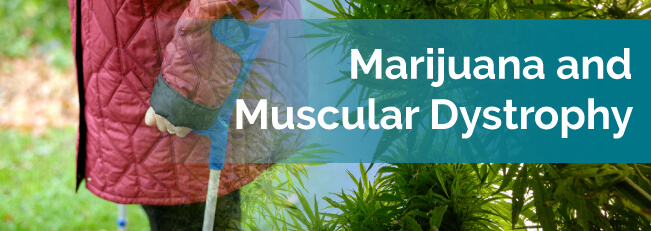
Marijuana treatment is approved in several states for a variety of conditions that include severe pain and other debilitating symptoms. Muscular dystrophy sufferers are finding relief with this newly accepted medical treatment.
All the MD disorders are inherited, meaning the genes causing the disorder are passed down through families. The age of onset, degree of muscle loss and weakness, rate at which the disorder progresses through the body, and the pattern of inheritance within the family can vary significantly among the MD disorders. Duchenne MD, the most common of all the MD disorders, for example, affects males at an early age, commonly between the ages of three and five years old. Duchenne MD also progresses rapidly, often leaving the sufferer unable to walk as early as age 12. Females in a Duchenne MD family have a 50 percent chance of passing the Duchenne MD gene down to their children. Myontic MD, on the other hand, typically waits until the adult years to show symptoms and progresses slower but can be marked by prolonged muscle spasms among other symptoms.
Medical marijuana effectively relieves extreme pain, including the nerve pain that opioids are used for. In most cases, marijuana is a better solution for pain relief than opioids because it can be used long-term for chronic pain. The brain does adapt to cannabis, but at a much slower rate than opioids. This means the dose does not have to rapidly increase to get the same results.
Medical cannabis products do not carry the same side effects as opioids, either. Opioids block pain signals and reduce respiration at the same time. Opioid overdoses often result in death because respiration becomes so slow that it stops entirely. Marijuana has no such side effects. If you get too much cannabis in your system, you might experience a period of anxiety or paranoia, but it is not fatal.
Find A Doctor Find A Dispensary
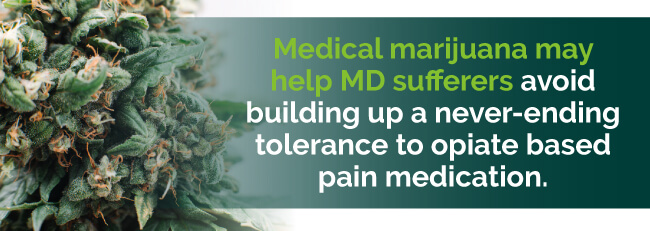
Medical marijuana may help MD sufferers who live with chronic pain avoid building up a never-ending tolerance to opiate based pain medication. A recent study looked at the effect of adding medical marijuana to the daily regime of patients who consume opiate based pain medication for chronic pain. The study found that the participants experienced an average drop in pain level of 27 percent while not significantly affecting the blood-levels of the prescription drugs. For MD patients, in particular, excessive levels of opiates in the blood can be extremely dangerous given the respiratory problems common to MD sufferers. The fact that medical marijuana was able to reduce pain levels without increasing opiate blood levels is important.
Smoking marijuana has been found to be the most effective and rapid mechanism for relaying the active compounds to the brain, thereby allowing the sufferer to feel immediate relief from pain as well as offering better control over medication levels. Smoking anything, however, is clearly not good for your lungs or respiratory system. An MD sufferer may have a particularly compromised respiratory system. Luckily, there is another, equally effective, yet healthier mechanism for using medical marijuana – vaporization. Because the active compounds in marijuana, known as cannabinoids, are volatile, they can be vaporized at a temperature level significantly lower than that needed to reach combustion, or smoke. As a result, hot air can simply be drawn through the marijuana, which in turn vaporizes the cannabinoids and frees them for inhalation.
Medical cannabis is also effective at reducing the length and severity of muscle spasms and cramps. Patients with MD can get very painful muscle cramps. A regular regime of cannabis treatment could reduce or possibly eliminate these incidents.
Unfortunately, there is no known cure for any of the MD disorders. Conventional treatment attempts to control seizures and muscle spasms as well as provide physical, respiratory and speech therapy in order to give the patient the best quality of life possible. Medical marijuana and Muscular Dystrophy has been known to help treat some of the side-effects associated with Muscular Dystrophy.
Unfortunately, all of the disorders that make up the muscular dystrophy, or MD, group are known to degenerate, or get worse over time. As a result, keeping the patient comfortable and as pain-free as possible is often one of the most prominent treatment goals. Among the common members of the group of MD disorders are Becker muscular dystrophy, Duchenne muscular dystrophy, Emery-Dreifuss muscular dystrophy, Facioscapulohumerol muscular dystrophy, Limb-girdle muscular dystrophy, Myotonia congenita, and Myotonic muscular dystrophy.
There are not many medical studies done on the use of cannabis to treat MD, although the medical community is continuing to make progress on proving the beneficial properties of medical marijuana. The results of some studies performed on the uses of medical cannabis for ALS can be applied to MD, as well, since ALS also involves muscle atrophy and weakness. Some studies have seen the following results of medical cannabis on ALS:
Several of these same treatment mechanisms could be useful in treating MD and eventually offer the basis for a cure to the disease. In the meantime, more studies and more testing are needed to clearly define the effects of marijuana on MD.
Anecdotal reports of MD patients finding relief through medical marijuana are encouraging. The effects on their quality of life can be so profound as to prompt them to move across the country to a state when medical cannabis is easily accessible. MD patients are finding relief from pain and improved sleep habits from medical marijuana use.
The mental health benefits of reducing chronic pain are measurable. Chronic pain can develop into a serious problem of its own, leading to mental health issues such as depression and anxiety. Living with a chronic disease like MD also contributes to mental health issues like depression and anxiety. Reducing the pain without causing dangerous side-effects improves mental outlook.
Medical marijuana is proven to reduce anxiety and promote relaxation in a number of different conditions. Relieving stress can give the brain a chance to rest and work on improved healing. MD is a chronic condition with no real cure, but in some cases, the symptoms can be managed for a normal life expectancy. The use of medical cannabis improves the chances of slowing the progression of the disease and the onset of symptoms.
The basis of medical cannabis treatment is finding the right combination of THC and CBD to meet your needs. There are three basic strains of cannabis plants, but thousands of hybrid varieties are bred for any number of ingredient combinations.
Medical marijuana therapy involves a certain amount of trial and error because everyone is different, but there are some guidelines to follow to make it easier to get what you need from your marijuana therapy. The strains that lend themselves to MD treatment include:
People suffering from MD often have a compromised respiratory system from the disease. Smoking marijuana, even though it has health benefits, would not be advisable under these circumstances. Vaporizing is a safer way of administering medical cannabis that does not harm the lungs. Vaporizing is not as hot as smoking and does not contain the by-products of burning.
There are other ways of consuming cannabis that do not rely on the respiratory system to deliver the medicine. For acute pain, you may want to get instant relief. Using a spray or a few drops of a tincture under your tongue can provide very fast relief. There are also topical products available that can be applied directly to the areas where it hurts. The relief from these applications is almost instant as well.
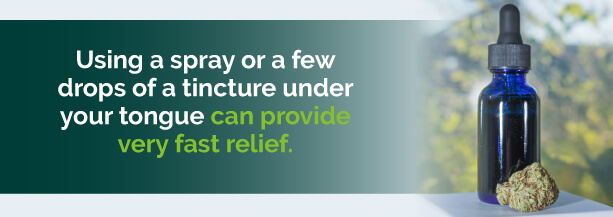
Edibles can be another helpful way to consume the benefits of medical cannabis for relief of MD symptoms. Capsules can require more swallowing muscle control than an MD patient has, but edibles can be chewed for easier consumption.
Medical marijuana doses can be adjusted for use in children and people with low body weight. It is safe for children because there are no real side-effects of medical cannabis treatments. Cannabis products are available in many different forms and with differing balances of THC, the psychoactive component that you might not need.
To get started exploring your MD treatment options with medical marijuana, you need to find a marijuana doctor to treat you. Do an online search for medical marijuana doctors. Our doctors will help you qualify as a marijuana patient and answer all of your questions about the medical marijuana program in your state.
Once you have a medical marijuana card, you can find a registered dispensary in your area. MarijuanaDoctors.com has a comprehensive list of dispensaries with information on how to get there and what to expect at your first visit. Even if you are new to medical marijuana, you will find all the support you need to get the treatment your condition requires.
Medical marijuana therapy can be life-changing, especially for those who suffer from chronic disease. MD patients who try cannabis are amazed at how it deals with their symptoms and improves their quality of life. Medical marijuana offers a brighter future for people suffering from muscular dystrophy and other painful chronic diseases.
For more information about how cannabis can be used to treat Muscular Dystrophy, check out our resources:
Find A Doctor Find A Dispensary
Muscular dystrophy encompasses an entire group of more than 30 inherited disorders, all of which cause the loss of skeletal muscle tissue and accompanying muscle weakness. Unfortunately, all of the disorders that make up the muscular dystrophy, or MD, group are known to degenerate, or get worse over time. As a result, keeping the patient comfortable and as pain-free as possible is often one of the most prominent treatment goals.
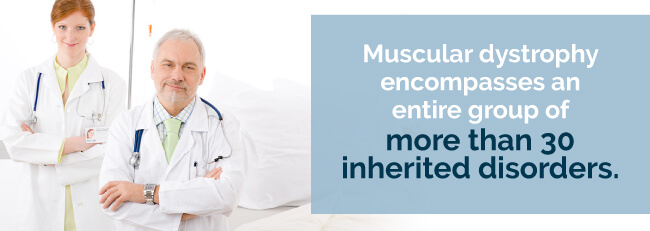
Among the common members of the group of MD disorders are:
The first case of MD was discovered in 1836, although the doctor did not know what he was dealing with. The general muscle weakness in a ten-year-old boy was attributed to tuberculosis. It wasn’t until 1852 when other similar cases were reported, four boys in one family, that the genetic component was explored. In 1868, a French neurologist named Duchenne further described the conditions of MD and possible neurologic and genetic origins.
Subsequent advances in molecular biology eventually revealed the causes and progression of MD. A genetic mutation causes defects in a specific muscle protein that affects the skeletal muscles. The defect results in progressive weakness that can affect the patient’s ability to walk and can ultimately impair heart and lung function.
The progressive muscle weakness creates poor posture and spinal deformities. These symptoms lead to poor balance as well as the tightening and shortening of leg muscles, foot muscles and soft tissue. This eventually results in an inability to walk. Once confined to a wheelchair, a person with MD deteriorates faster.
There is no cure at this time for MD. Genetic testing is available to determine if a person carries this genetic disease. Often mothers and sisters of boys who have MD actually carry the disease but do not show any symptoms. The only way to prevent MD right now is to avoid passing it on to the next generation.
For those born with MD who show symptoms, the goal of treatment is to slow the progression of the disease. Some medications show promise in promoting muscle development despite the presence of MD, and scientists are working on a way to replace the defective gene to halt the disease before it gets started.
Other forms of treatment include keeping muscles working and moving as long as possible. Spinal deformities can be prevented with physical therapy that keeps joints from assuming abnormal positions. Breathing exercises can help maintain normal respiratory function.
One of the biggest impediments to exercise and physical therapy for MD patients is pain. The tightening and shortening of muscles and soft tissue is painful. As those shorter muscles pull joints into abnormal positions, there is additional pain. Many MD patients experience extreme muscle contractions that are very painful.
There are nine different types of MD that vary in their onset and severity. They are all caused by a genetic defect and are all degenerative:
1. Myotonic
Most common form of MD for adults that is caused by a repeat in their genetic code.
2. Duchenne
Accounting for more than 50% of cases, Duchenne is the most severe form of MD affecting children.
3. Becker
Similar in nature to Duchenne, Becker MD can move quickly or slowly.
4. Limb-Girdle
Both boys and girls can inherit the defective gene from either parent or, in more severe cases, the same genetic defect from both parents.
5. Facioscapulohumeral
This form of MD affects the face, shoulders and upper arms, although the exact gene that causes it is not known.
6. Congenital
Most often caused by a genetic defect in muscle fiber proteins but can sometimes affect the central nervous system.
7. Oculopharyngeal
This form of MD is common in specific ethnic groups including French-Canadian, Jewish Ashkenazi and Hispanics from the southwestern United States.
8. Distal
Distal MD can present in men and women, and it affects the forearms, lower legs, hands and feet.
9. Emery-Dreifuss
This MD variation is caused by a defect in the proteins surrounding cell nucleus, and it affects boys primarily.
MD is considered a rare disease by the National Institutes of Health because it affects fewer than 200,000 people in the US population. Each year, between 500 and 600 male infants are diagnosed with MD, putting the incidence rate at approximately one in every 544,000. For the thousands who suffer, MD is a debilitating and potentially fatal condition.
MD itself does not typically cause severe pain; however, secondary chronic pain associated with the disorders is estimated to affect two-thirds of the sufferers. Pain is caused by muscle cramps or spasms as well as stiff joints, pressure sores and muscle twitches. While traditional treatments such as physical therapy, heat application and exercise can alleviate some of the pain associated with MD, narcotic pain medication is often required at some point.
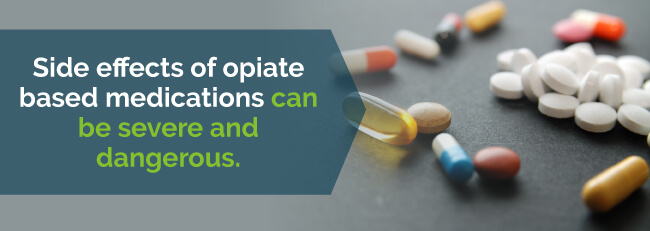
Opiates, the group of pain medications typically prescribed for suffers of chronic pain, can help to alleviate pain; however, they also come at a high cost. Side effects of opiate based medications can be severe and dangerous. Aside from the risk of addiction, opiate based pain medications can also cause severe constipation, dizziness, drowsiness, respiratory depression, nausea, vomiting, difficulty urinating, itching and a variety of other negative side effects. In addition, patients who use opiate based narcotic pain medications typically build up a tolerance to the medication rather quickly, meaning more of the same medication is needed to control the pain.
Corticosteroids are also used to maintain muscle strength and possibly slow the progression of the disease. Steroids increase the body’s production of proteins that help build muscles, and they also help reduce the pain of inflammation and sore muscles. Over long periods of time, however, corticosteroids can weaken bones, increasing the risk of fractures. However, steroids can also cause weight gain, making it more difficult for atrophied muscles to move the body.
Heart damage due to MD can be treated with medication. Beta blockers or ACE inhibitors can be used to reduce high blood pressure that results from damaged muscles in the heart. These are not long-term solutions, though, since MD is a degenerative disease. Eventually, the heart damage could become too severe to be controlled with medication.